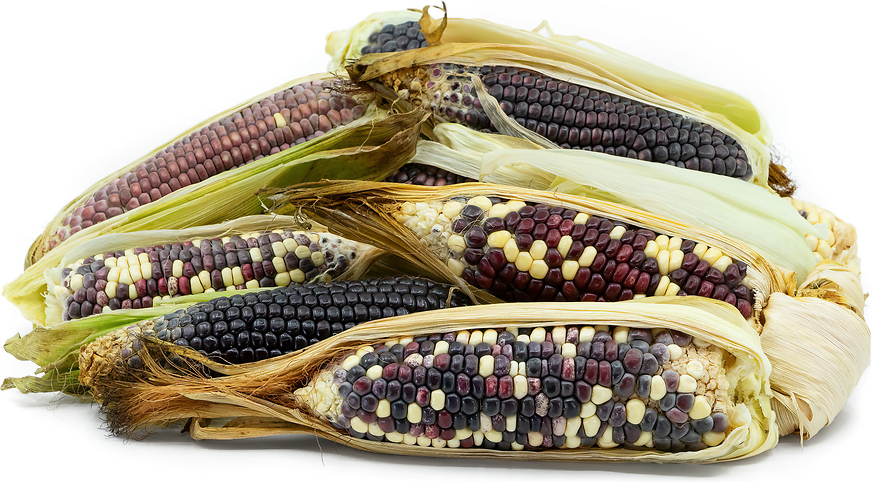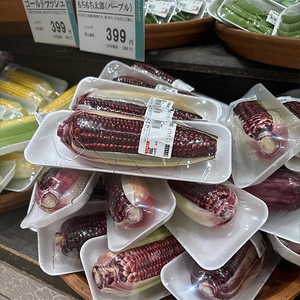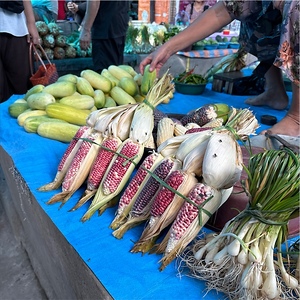


Sticky Corn
Estimated Inventory, lb : 0
Description/Taste
Sticky corn is variable in size, depending on the specific variety, and ranges from small to medium, averaging 10 to 15 centimeters in length and 5 to 8 centimeters in diameter. The cobs have a cylindrical, straight appearance and can be broad, short, and thick or elongated and slender. The cobs taper to a point on the non-stem end and have a flat, blunt stem end. Sticky corn cobs are encased in layers of a papery, fibrous, and sheath-like husk and delicate, stringy fibers known as silks. The husks are generally pale green, turning brown and drying out with age. When the husks are removed, the cobs are covered in rows of oval, angular, and flat, fleshy kernels. Each kernel has a smooth, taut, and semi-glossy surface and some varieties may be tightly packed while others are looser. Sticky corn kernels showcase variegated hues of yellow, white, cream-colored, maroon, red, red-pink, to dark purple. Each variety will exhibit its own unique color pattern and cultivation habits will impact the strength of pigment. Inside each kernel, the endosperm is aqueous, firm, springy, waxy, and starchy. Sticky corn must be cooked before consumption and has a crisp, crunchy, and chewy texture with a neutral, sweet, and starchy flavor.
Seasons/Availability
Sticky corn is typically harvested between May through October, varying with the geographical region, climate, and specific variety.
Current Facts
Sticky corn, botanically classified as Zea mays var. ceratina, is a category of corn varieties with a distinct, starchy consistency, belonging to the Poaceae family. There are many varieties of Sticky corn grown worldwide, but the first known type of Sticky corn is thought to have been discovered in China. Sticky corn is distinct from other types of corn as it contains high amounts of amylopectin, a specific type of starch. This starch gives the kernels their notably chewy, sticky texture when cooked, also contributing to the variety’s “sticky” name. Sticky corn is also known as Waxy and Glutinous corn. Since its introduction into commercial markets, Sticky corn has become one of the most popular types of corn consumed in culinary preparations in Asia. Sticky corn is traditionally cooked and has a versatile nature, favored for its ability to add a chewy, starchy, and crunchy texture to savory or sweet dishes.
Nutritional Value
Sticky corn has not been extensively studied for its nutritional properties. Some sources claim the corn is a source of fiber to regulate the digestive tract, magnesium to control nerve functions, potassium to balance fluid levels within the body, and vitamin A to maintain healthy organs. Sticky corn may also provide vitamin C to strengthen the immune system, vitamin K to assist in faster wound healing, vitamin E to protect the cells against the damage caused by free radicals, and B vitamins. Pigmented Sticky corn varieties with red-purple hues contain anthocyanins, an organic compound that contributes antioxidant-like properties to reduce inflammation.
Applications
Sticky corn has a mild, starchy, subtly sweet, and neutral flavor suited for cooked preparations. The kernels must be cooked to soften their tough and chewy texture and are favored in savory and sweet dishes. Sticky corn is a staple ingredient throughout Asia. In China, Sticky corn is the most popularly consumed corn type and is prepared in stir-fries, porridges, and dumplings. It is also incorporated into cakes, sliced and roasted into rib-like strips, or incorporated into soups. Similarly to Chinese recipes, Japanese and Korean recipes often overlap in style, and Sticky corn is boiled and served as a simple street food throughout these cultures. The chewy kernels are also grilled, steamed, or fried, added to puddings, tossed into salads, or cooked and coated in sweet and sour sauces. In Japan, Sticky corn is sometimes fried into tempura. Outside of East Asia, Sticky corn is prevalent in local markets in Northeastern India. Sticky corn kernels are added to curries, stir-fries, and jellies or they are roasted over an open fire to develop a smoky flavor. Sticky corn cobs are also boiled and coated in butter and chaat masala as a side dish. Beyond the kernels, Sticky corn silks are sometimes boiled and steeped into medicinal tea. The starch from the kernels is also extracted and used in dried sauce mixes, pie fillings, and frozen foods. Sticky corn pairs well with herbs such as thyme, rosemary, basil, dill, and parsley, spices including paprika, cumin, and garlic powder, edamame, potatoes, bell peppers, carrots, and chile peppers. Whole cobs of Sticky corn will keep for a few days when stored in the refrigerator’s crisper drawer. It is recommended to keep the cobs in their husks or store in a damp paper towel to help preserve moisture. Sticky corn can also be frozen or dried for extended use.
Ethnic/Cultural Info
Sticky corn is featured in several legends across China. In the Liaoning Province, Sticky corn is viewed as a life-saving crop due to stories about communities in the southern peninsular regions of the province struggling with famine. Legend has it that famine struck the Liaodong Peninsula for several years in ancient times. During this famine, an elderly man and woman appeared one day and gave the villagers a new type of seed to plant. The seeds looked like strange human teeth and the villagers were in awe of the seeds. The man encouraged the village to plant the seeds to reap a plentiful harvest in the fall that could feed the community and their animals. One villager named Liu Xiucai eventually asked the man and woman where they were from, and the man said they were from the Penglai Mountain. In Chinese mythology, Penglai is a mythical place where immortals reside. The elderly man and woman suddenly disappeared, and the villagers immediately planted the seeds that the immortals called corn. In the fall, the corn harvest was abundant, and the once starving village was filled with food, feeding generations to come.
Geography/History
Sticky corn is native to China and was thought to have been created from a natural mutation occurring on ancient corn species originally introduced to Asia from the Americas sometime before the 16th century. The exact date of origin of Sticky corn is unknown, but the natural mutation was discovered growing in a corn field in the Yunnan or Guangxi Province in China and was chosen for further evaluation. The new type of corn was selectively bred over time, creating starchier kernels with a substantial texture, size, and flavor. These plants were later selected for trials and cultivation, creating the many different types of Sticky corn sold in commercial markets. After its discovery, Sticky corn was cultivated throughout southwestern China, mainly in Guangxi, Guizhou, Sichuan, and Yunnan Provinces. It also expanded in production into Jiangshu and Zhejiang Provinces. Sticky corn was later introduced to others parts of Asia and was sent to the United States in the early 20th century. In the 1930s and 1940s, Sticky corn was studied and trialed in the United States, becoming popular for cultivation in the 1960s. One of the most notable markers was when a researcher in 1922 discovered that Sticky corn contained solely amylopectin, a waxy starch. This starch was adopted into American processing during World War II as a replacement for tapioca starch when the Japanese halted trade relations. Sticky corn starch quickly became the dominant starch in the food, textile, and paper industries and has since been used into the modern day. Today, Sticky corn is cultivated throughout East and Southeast Asia, especially in China, Japan, Korea, Taiwan, Vietnam, and Thailand. Varieties have also been introduced into Myanmar, Nepal, and Northeastern India, where it is grown as a food source. The Sticky corn featured in the photograph above was sourced from the Wednesday Bazaar at the Dimapur Supermarket in Dimapur, a city in Nagaland, India.










